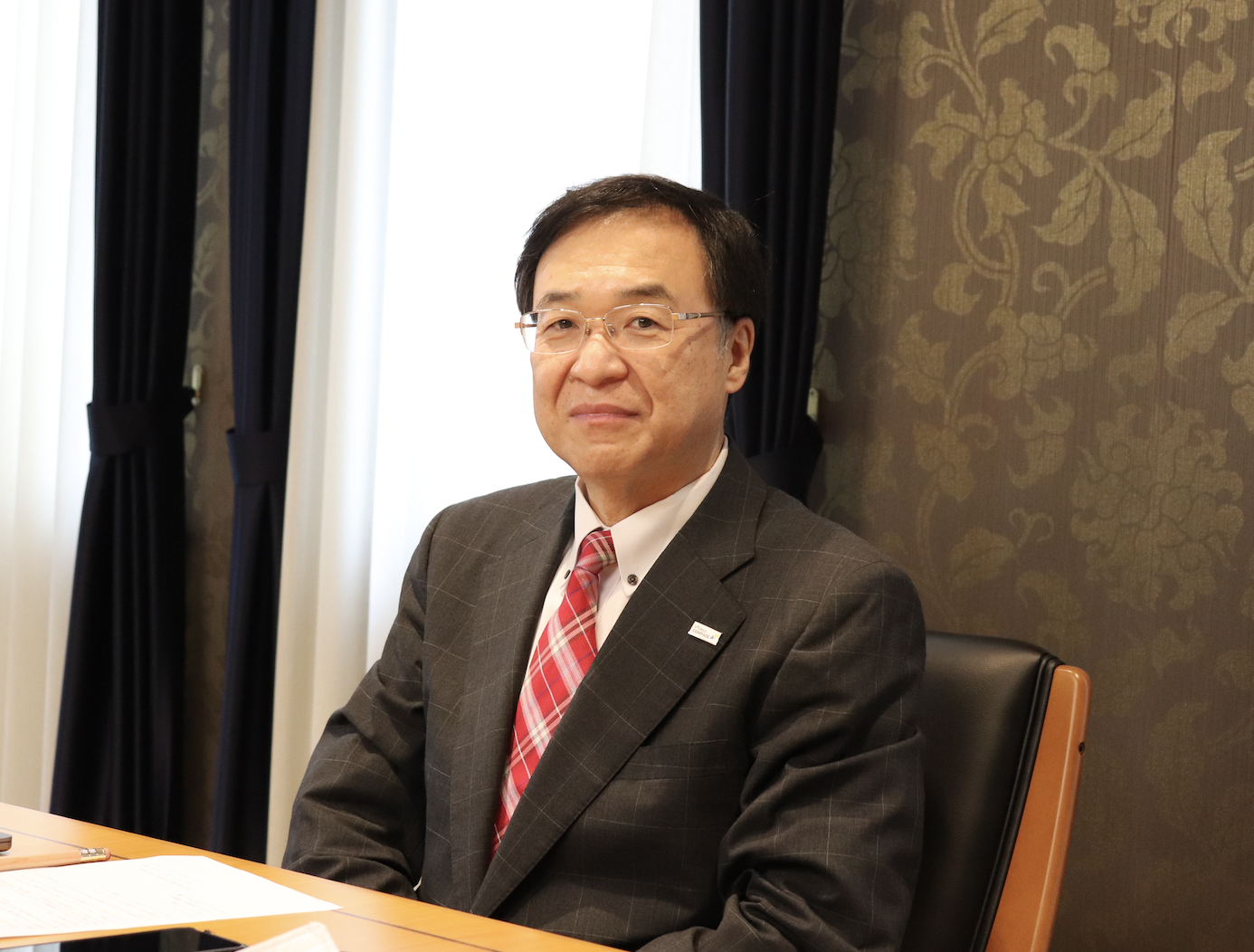Tackling sustainability challenges since 1994 |GX and UTokyo 01|Executive Vice President Tatsuya Okubo

This series looks into green transformation (GX)-related initiatives at UTokyo, through interviews with key faculty members. The university is taking actions to realize a sustainable society within the Earth’s capacity.

The UTokyo GX campaign logo, launched in October 2022, depicts blue and yellow ginkgo leaves, the symbol of UTokyo, rotating and merging to create a green color. The transformation of the ginkgo leaves’ shapes and color while retaining their original form also represents the university’s proactive approach toward GX.
One of the first universities to focus on sustainability
“UTokyo is actually the first university in the world to turn its eyes on sustainability and to start taking actions,” said UTokyo Executive Vice President Tatsuya Okubo, who steers the university’s efforts to promote green transformation. The direct impetus for the university to start taking sustainability-related actions was the launch of the Alliance for Global Sustainability (AGS) initiative in 1994, together with the Massachusetts Institute of Technology (MIT) in the U.S. and the Swiss Federal Institute of Technology (ETH). (The Chalmers University of Technology in Sweden also joined the partnership in 2001.) Okubo noted that this alliance likely is the first global sustainability-related effort made by universities.
“It was in the late 1980s when the problem of greenhouse gases, caused when the use of energy emits carbon dioxide (CO2) and affects the global environment, became apparent. In line with such growing awareness in the world, the university set up the Engineering Research Laboratory on Global Environment in the Faculty of Engineering in 1991. Emeritus Professor Yoichi Kaya, who was a member of the Club of Rome (a group comprising diverse thought leaders, which was formed to address the multiple crises facing humanity and our planet), served as the head of the new entity. Professors Hiroshi Komiyama (later UTokyo president) and Tomonori Matsuo supported him as young faculty members at the time. With these activities as a backdrop, UTokyo approached the two overseas universities and AGS was created,” Okubo explained.

Starting with an international workshop held at MIT in 1994, AGS has held 46 international conferences and 30 conferences in Japan. The alliance is currently managed by UTokyo’s Institute for Future Initiatives (IFI).
Also, the Graduate School of Frontier Sciences, launched in 1998, has placed environmental studies as one of its three pillars. In 2005, the university established the Integrated Research System for Sustainability Science (IR3S) under the Committee for Presidential Initiatives (IR3S, together with the Policy Alternatives Research Institute, was integrated as IFI in 2019). Then in 2008, UTokyo set up the Todai Sustainable Campus Project (TSCP), with the aim of realizing a sustainable campus.
“IR3S also launched the international academic journal Sustainability Science in 2006 together with the United Nations University. So, it’s not like we jumped on the bandwagon recently given the growing public interest. We are here today because of our predecessors’ efforts,” Okubo said.
Against this background, UTokyo joined the United Nations’ global Race to Zero campaign in 2021.
Student initiatives addressing environmental issues
In addition to researchers, UTokyo students also have been taking part in sustainability activities, as important stakeholders of the university. Among them, a student environmental group called Kankyo Sanshiro (“Environment Sanshiro." Sanshiro is the name of a pond in Hongo Campus), launched in 1993, is widely deemed as the pioneer in this field. With the belief that environmental problems are also a social issue, the group has been working on several projects, including activities to raise awareness, focusing on Komaba Pond (also known as Ichiniro Pond) in Komaba Campus, and educational events to discuss environmental problems with elementary school students. As for TSCP, the initiative launched a student committee in 2015. Since then, the committee has been contributing to realize a sustainable campus from the perspective of students, who are the largest group on our campus. Today, some former members of these student initiatives are playing leading roles as faculty members in advancing the university’s GX.
“Associate Professor Masahiro Sugiyama, who is collaborating with student GX initiatives in the Future Society Initiative, is a former key member of student group Kankyo Sanshiro. Associate Professor Yasunori Kikuchi, who is currently compiling the UTokyo Climate Action for the Race to Zero report, was a young AGS member. UTokyo has a history of students’ active participation in what is now known as GX,” Okubo said.
The Race to Zero campaign aims to achieve zero greenhouse gas emissions worldwide by 2050. While many overseas universities have joined the global campaign, UTokyo and the Chiba University of Commerce are the only universities in Japan taking part in the U.N.-led drive. The lack of participation probably is due to low environmental awareness in Japan and that achieving the net zero target is extremely difficult, Okubo noted. But if UTokyo is able to achieve such a difficult goal, it would send an important message to society. It was with this belief that the university has placed GX as one of the pillars of UTokyo Compass, a statement of the guiding principles of the university announced in 2021. This spring, the university also launched the GX Promotion Subcommittee under the umbrella of the FSI headquarters with four task forces: Global Commons Task Force, Campus GX Task Force, GX Communication Task Force and Student GX Initiatives Task Force. In addition to that, the GX Promotion Group was also set up as an administrative organization in 2022.
“Although we are getting the systems in place, reaching the goal is not that simple. I feel a deep sense of responsibility as the executive vice president in charge of GX,” Okubo said. “The net zero emission goal is something that needs to be achieved by the entire planet. UTokyo realizing the goal alone won’t be a significant contribution on a global scale. But if the university’s achievement could encourage society to change and prompt people to modify their behavior, then the amount of emissions from households and the whole society would decrease dramatically. What we need to do now is to grasp the amount of CO2 being emitted by our actions. I want to create a mechanism for that.”
Displaying amount of CO2 emissions on cafeteria menus
One such mechanism the university is currently considering is to display the amount of CO2 emissions on UTokyo Co-op cafeteria menus, similar to that currently used to indicate calories and nutrients. By visualizing the amount of CO2 emitted in preparing the food, people can realize that procurement of imported ingredients produces a lot of CO2, and that could lead more of them to start choosing dishes made with domestic ingredients instead. We may face various challenges, but we have already begun the discussion.
Research on life cycle assessment (LCA), which is a prerequisite for this endeavor, is also an urgent topic. In addition to the two research entities directly related to GX — the Collaborative Research Organization for Comprehensive Energy Sciences and the UTokyo Center for Climate Solutions — the university is also preparing to launch an LCA-related collaborative research organization.
On the educational front, UTokyo kicked off GX-themed classes in October as a part of the Academic Frontier Lecture series. It is also trying to make the GX-related classes more accessible, as common subjects, for all students. The SPRING GX project, which supports 600 doctoral students and trains them to become leaders in the fields of GX, is also underway. In terms of regional collaboration, the university has started a partnership centering on GX with four universities in Tokyo’s Bunkyo ward, where the Hongo Campus is located: Toyo University, Nihon Pharmaceutical University, Ochanomizu University and Japan Women’s University. A kickoff symposium is scheduled to be held in December.
“We are now focusing on CO2. But UTokyo’s GX is not just about CO2. Cutting CO2 is the minimum requirement considering the sustainability of the Earth. But there is also a mountain of problems piling up, including biodiversity issues. As the university’s executive vice president tasked with GX, I will continue to make every effort for realizing a sustainable planet,” Okubo said.
The strength of the university, which has been accumulating activities in every field of research, education and social cooperation, will be tested in this GX global initiative.






